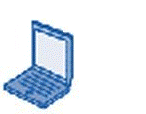 IEEE 802.11b
IEEE 802.11b
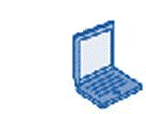
 IEEE 802.11b
IEEE 802.11b

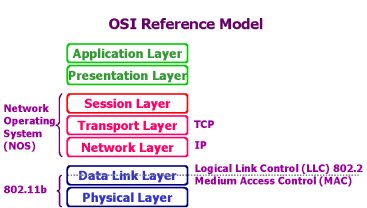
IEEE 802.11b "High Rate" standard wireless local area network (WLAN) operates in the 2.4GHz (2.4 to 2.483 GHz) unlicensed Radio Frequency (RF) band and can transmit up to 11Mbps (Megabits per second). It was released in September 1999 after the Institute of Electronic and Electrical Engineers (IEEE) had released IEEE 802.11 in June 1997.
IEEE 802.11b standard defines only two bottom levels of OSI (Open Systems Interconnection) reference model, the Physical Layer (PHY) and the Data Link Layer (Medium Access Control, MAC sublayer).
IEEE 802.11b defines two pieces of equipment, a wireless station, which is usually a PC or a Laptop with a wireless network interface card (NIC), and an Access Point (AP),which acts as a bridge between the wireless stations and Distribution System (DS) or wired networks. There are two operation modes in IEEE 802.11b, Infrastructure Mode and Ac Hoc Mode.
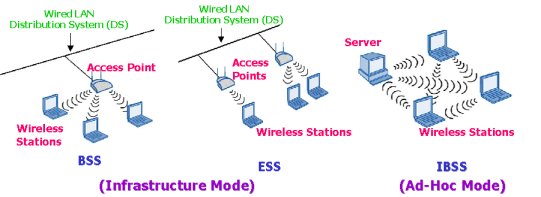
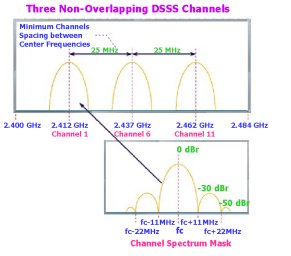
The physical layer (PHY) covers the physical interface between devices and is concerned with transmitting raw bits over the communication channel. IEEE 802.11b physical layer is an extension to IEEE 802.11 physical layer which supports 1 and 2 Mbps. IEEE 802.11b can support higher data rates of 5.5 and 11 Mbps by using Complementary Code Keying (CCK) with Quadrature Phase Shift Keying (QPSK) modulation and Direct-Sequence Spread-Spectrum (DSSS) technology.
In addition, IEEE 802.11b defines dynamic rate shifting, allowing data rates to be automatically adjusted for noisy conditions. This means IEEE 802.11b devices will transmit at lower speeds, 5.5 Mbps, 2 Mbps, and 1 Mps under noisy conditions. When the devices move back within the range of a higher-speed transmission, the connection will automatically speed up again.
Traditionally, IEEE 802.11 uses either a FHSS (frequency-hopping spread spectrum) or DSSS technology. Both are good solutions for transmission data rate of 1 to 2 Mbps.[2] However, in the United States, IEEE 802.11b cannot use FHSS for higher speeds without violating Federal Communications Commission (FCC) regulations.[1]
| IEEE 802.11b Data Rate Specifications | ||||
| Data Rate | Modulation | Symbol Rate | Bits/Symbol | |
| 1 Mbps | 11 (Barker Sequence) | BPSK | 1 MSps | 1 |
| 2 Mbps | 11 (Barker Sequence) | QPSK | 1 MSps | 2 |
| 5.5 Mbps | 8 (CCK) | QPSK | 1.375 MSps | 4 |
| 11 Mbps | 8 (CCK) | QPSK | 1.375 MSps | 8 |
| Note: | Mbps | Megabits per second |
| MSps | Million Symbols per second | |
| BPSK | Binary Phase Shift Keying uses one phase shift for each bit. | |
| QPSK | Quadrature Phase Shift Keying uses four rotations (0, 90, 180 and 270 degrees) | |
| CCK | Complementary Code Keying uses 4 bits per carrier for 5.5 Mbps, and 8 bits per carrier for 11 Mbps |
IEEE 802.11b physical layer is split into two parts, the Physical Layer Convergence Protocol (PLCP) and the Physical Medium Dependent (PMD) sublayer. The PMD takes care of the wireless encoding. The PLCP presents a common interface for MAC sublayer to write to and provides carrier sense and CCA (Clear Channel Assessment).[6]
PLCP has two structures, a long and a short preamble. All compliant 802.11b systems have to support the long preamble. The short preamble option is provided in the standard to improve the efficiency of a network's throughput when transmitting special data such as voice, VoIP (Voice-over IP) and streaming video.
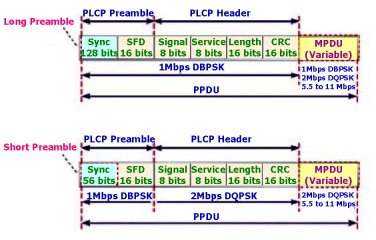
The MAC sublayer of the IEEE 802.11b serves as the interface between the physical layer and the host device. It supports both Infrastructure and Ad Hoc operation modes. Two robustness features in IEEE 802.11b MAC sublayer are Cyclic Redundancy Check (CRC) and Packet Fragmentation. Each packet has a CRC calculated and attached to ensure that the data are not corrupted in transit. Packet Fragmentation will send large packets in small pieces when sent over the air. This has two advantages. The first advantage is to reduce the need for retransmission because the probability of a packet getting corrupted increases with the packet size. The second advantage is that in case of packet corruption, the node needs to retransmit only one small fragment, therefore it is faster.
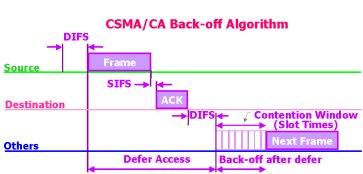
IEEE 802.11b uses Carrier Sense Multiple Access/Collision Avoidance (CSMA/CA). CSMA/CA is referred to as the Distributed Coordination Function (DCF). This requires each station to listen for other users. If the channel is idle, the station may transmit. However if it is busy, each station must wait until transmission stops at which time the receiver sends ACK. Then each station must wait for a time equal to DIFS, plus a random number of slot times for next transmission in order to avoid collisions over the medium.
The CSMA/CA also includes an optional Point Coordination Function (PCF), which is used to set up an access point as a point coordinator. In this function, the point coordinator assigns priority to each client in a given transmission frame. The PCF option is used for multimedia traffic.[2]
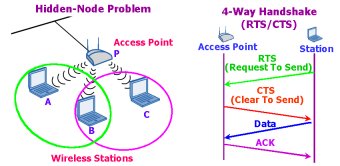
An assumption of Physical Carrier Sense is that every station can "hear" all other stations. This is not always true. In "The Hidden-Node Problem," wireless stations A, B and C all can see Access Point P. A and B can see each other, and B and C can see each other, but A cannot see C.
To handle this problem, IEEE 802.11b specifies an optional Request to Send/Clear to Send (RTS/CTS), 4-Way Handshake, protocol. This protocol reduces the probability of a collision on the receiver area. When a sending station wants to transmit data, it first sends an RTS and waits for the Access Point to reply with a CTS. Since all stations in the network can hear the Access Point, the CTS causes them to delay any intended transmissions, allowing the sending station to transmit and receive a packet acknowledgment(ACK).
| The usage of different Address fields (1-4) according to ToDS and FromDs bits setting | |||||
| Note: | DA | Destination Address | SA | Source Address | ||||
| RA | Recipient Address | TA | Transmitter Address | APA | Access Point Address |
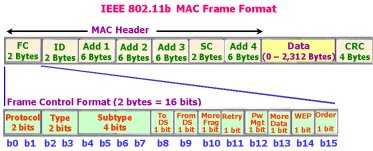
Frame Control Format
[4]
| Type and Subtype of the Frame Control Field | |||
| 00 | Management | 0000 | Association Request | 00 | Management | 0001 | Association Response | 00 | Management | 0010 | Reassociation Request | 00 | Management | 0011 | Reassociation Response | 00 | Management | 0100 | Probe Request | 00 | Management | 0101 | Probe Response | 00 | Management | 0110-0111 | Reserved | 00 | Management | 1000 | Beacon | 00 | Management | 1001 | ATIM | 00 | Management | 1010 | Disassociation | 00 | Management | 1100 | Deauthentication | 00 | Management | 1101-1111 | Reserved | 01 | Control | 0000-0001 | Reserved | 01 | Control | 1010 | PS-Poll | 01 | Control | 1011 | RTS | 01 | Control | 1100 | CTS | 01 | Control | 1101 | ACK | 01 | Control | 1110 | CF End | 01 | Control | 1111 | CF End + CF-ACK | 10 | Data | 0000 | Data | 10 | Data | 0001 | Data + CF-ACK | 10 | Data | 0010 | Data + CF-Poll | 10 | Data | 0011 | Data + CF-ACK + CF-Poll | 10 | Data | 0100 | Null Function (no data) | 10 | Data | 0101 | CF-ACK (no data) | 10 | Data | 0110 | CF-Poll (no data) | 10 | Data | 0111 | CF-ACK + CF-Poll(no data) | 10 | Data | 1000-1111 | Reserved | 10 | Data | 0000-1111 | Reserved |
[1] 3com, "IEEE 802.11b Wireless LANs Wireless Freedom at Ethernet Speeds," [Online document],25 April 2000. Available URL: http://www.3com.com/technology/tech_net/white_papers/503072.html
[2] Al Petrick, "Standard and Protocols IEEE 802.11 b Wireless Ethernets," [Online document], June 2000. Available URL: http://www.csdmag.com/main/2000/06/0006stand.htm
[3] Angela Champness, "IEEE 802.11 DSSS: The Path To High Speed Wireless Data Networking," [Online document]. Available URL: http://www.wi-fi.net/downloads/weca80211boverview.pdf
[4] Breezecom, "IEEE 802.11 Technical Tutorial," [Online document]. Available URL: http://www.breezecom.com/Materials/PDFFiles/802.11Tut.pdf
[5] Dr. Arian Durresi, "Wireless Data Networking IEEE 802.11 & Overview of IEEE 802.11b," [Online document]. Available URL: http://www.cis.ohio-state.edu/~durresi/presentations/802.11.pdf
[6] Joel Conover, "Anatomy of IEEE 802.11b Wireless," [Online document], 7 August 2000, Available URL: http://www.networkcomputing.com/1115/1115ws2.html
[7] "Introduction to IEEE 802.11," [Online document]. Available URL: http://www.intelligraphics.com/articles/80211_article.html
